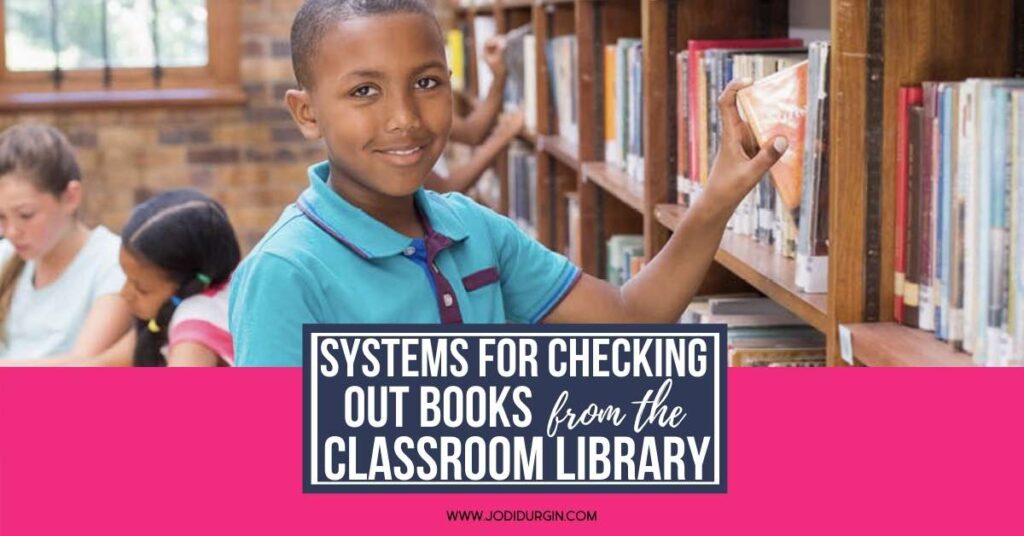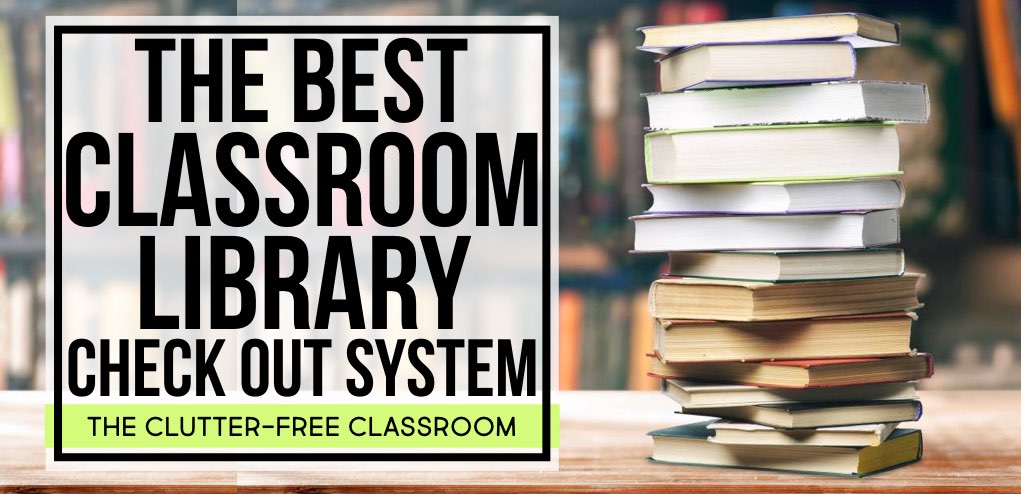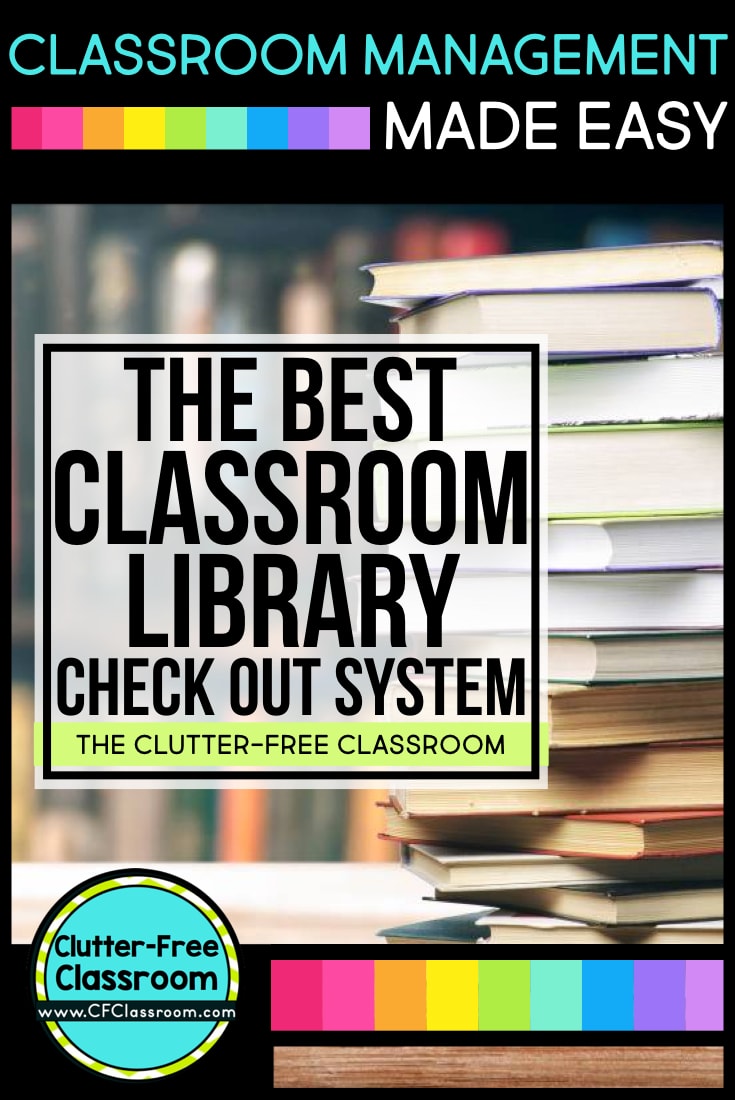I often get asked for advice on creating a classroom library checkout system. Teachers invest a lot of their own personal time and money into accumulating books and setting up a class library. While they want those books in the hands of their students, they have just cause to be concerned that books will get damaged or lost. Luckily, I have some solutions.
Below is a list of 15 tips that I’m sharing based on what worked well in my classroom for over a decade. My system was very easy to manage and 98% effective, which was good enough for me! My system is easy to manage because there is no system. You read that right… I don’t have a system. Over the years, I experimented with elaborate check out systems. I even bought adhesive pockets to put into my books at one point. I’ve tried sign out sheets. I have played around with having students or parent volunteers play the role of a librarian to track where the books were and when they were returned.
I found it was all a waste of time and, quite honestly, books still went missing or became damaged, so I stopped trying to monitor which students were in possession of which books. Instead, I simply set up a few guidelines for using the library and borrowing my books. Learn about the simple guidelines I put in place by reading the 15 classroom library checkout system tips below!

15 Tips for Lending Out Books to Students
Below are 10 tips for lending out classroom library books to elementary students. You’ll have the information you need to create your own classroom library checkout system.
12 Tips for Lending Books to Read in the Classroom
1. Only Allow 3 Books to be Borrowed at a Time
Allow students to take three books at a time. This gives them some variety to choose from, but is still an easy amount to manage.
2. Give Each Student a Book Bag
I found using gallon-sized Ziploc bag works best. They needed to be replaced throughout the year, but since they don’t cost a lot that was not a problem. I had used canvas book bags in the past for each student, but much preferred the plastic bags because I could write their names on the outside, easily see how many books they had, and they could even keep a pencil inside for logging notes into their interactive bookmarks.
3. Do Not Allow the Books to Leave the Classroom
Don’t allow the books in the book bag to leave the classroom. This will solve the problem of lost books. There may be times a child doesn’t know where a book is, but this way it will be more likely to turn up.
4. Label All of Your Books
I used a Sharpie and wrote my name on the front and the back of each book. There were times a book “accidentally” was taken out of the classroom, but they almost always returned.
5. Keep Your Classroom Library Organized
I made sure my library was well organized. This was accomplished by engaging my students in many activities to teach them about genre (you can learn more about how I did that here), so I could organize the classroom library like a real library or bookstore. They will never walk into a Barnes and Noble and ask for a “level L picture book” or “something with a Lexile Level in the 600 range”, so I felt strongly that they should understand real world organizational systems of books. Their understanding of genre, in conjunction with sturdy containers in appropriate sizes and a labeling system, made it easy for responsible students to keep the library organized.
6. Use a Book Hospital
We also had a “book hospital.” This was simply a dishpan that was labeled. The students knew to place “injured books” inside. Parent volunteers knew to check the hospital when they came in to help and would automatically fix them and put them into the book return location for my student librarian to re-shelve.
9. Set Clear Expectations
Set very clear expectations. Remind them that the books are part of the community and need to be treated with care and respect so that future students can enjoy them.
7. Explain, Model, and Practice Routines
Plan to explain, model, and practice the routines for browsing, borrowing, and returning books from the classroom library just like you would any other classroom procedure or routine.
8. Open Your Library Slowly
Consider opening your library slowly. Allow students to select from specific areas at first and then expand it as the routines become established.
10. Assign a Classroom Librarian
Being in charge of the library was one of our classroom jobs. When a student was finished with a book, he or she would place it into the return bin and the classroom librarian was responsible for putting it back into the correct spot. Don’t randomly pick students to be the classroom librarian. Be very selective and choose responsible kids who will take the job seriously.
11. Close Your Classroom Library when you are Absent
Add the words, “The classroom library is CLOSED when I am absent” to your sub plans. Trust me on this one.
12. Utilize Technology
If you would prefer to experiment with a more elaborate classroom library checkout system, there are options such as classroom library checkout scanners and classroom library checkout apps that some teachers have found useful.

3 Tips for Lending Books to Read at Home
Because I stopped allowing my students to take my classroom library books home, it was important to me to find a new way to make books available outside the classroom for all my readers. I knew many of them did not have access to much literature after school hours. My solution had three parts.
1. Create a Separate Lending Library
I created a lending library in my classroom. This was a smaller selection of books that were only used for the purpose of taking them home to enjoy. I stocked this little library with books that had been donated to me, books that were duplicates of titles in the classroom library, and books that were in sad shape, but still had some life left in them.
In addition to the actual books that were available for checkout, I kept a collection of printable books (from www.readingatoz.com) stocked for take-home use. It is a membership site that requires a subscription, but you can do a free trial membership.
2. Use a Sign Out Sheet
I had a sign-out sheet to make it feel more official, but in all honesty I never looked at it. It was simply a method of increasing responsibility and accountability.
3. Collaborate with the School Librarian
Finally, for my students who I knew truly lacked quality literature at home, I collaborated with the school librarian and made arrangements for them to take home an extra book each week.
In closing, I hope you found these tips for managing books that are borrowed from your classroom library helpful. In my experience, a couple books may become damaged or lost, but honestly, no more so than when I was logging every book a student was using. The time savings is huge and more than makes up for the very rarely misplaced book. If you found this post helpful, then you may also be interested in these posts:
- Back to School Read Alouds for Elementary Students
- Classroom Paper Organization Ideas that Work
- Classroom Management Strategies for Elementary Teachers


